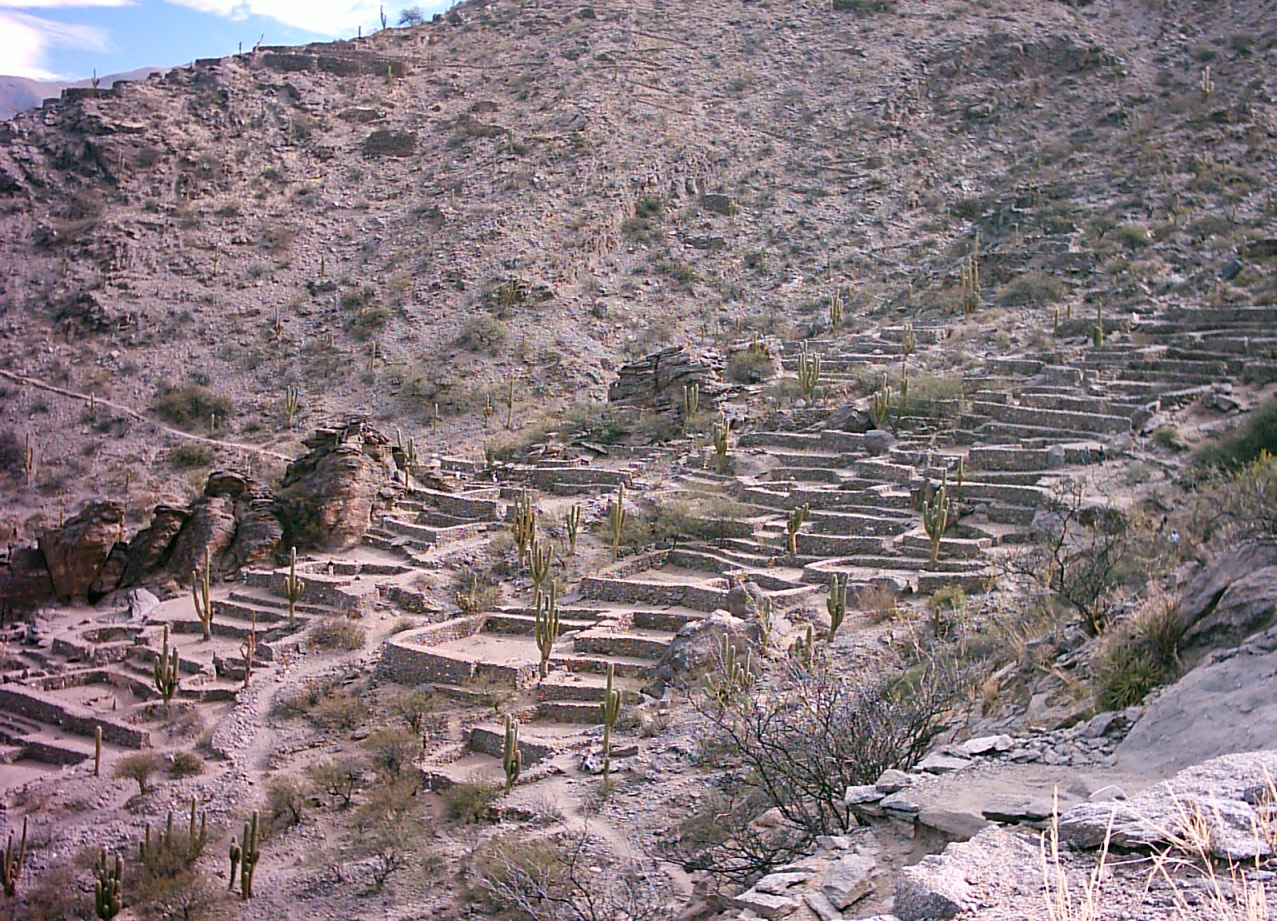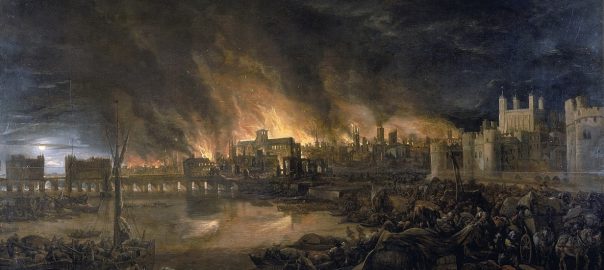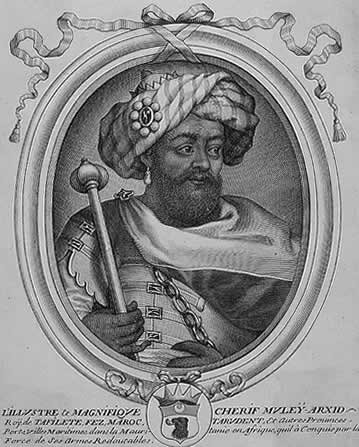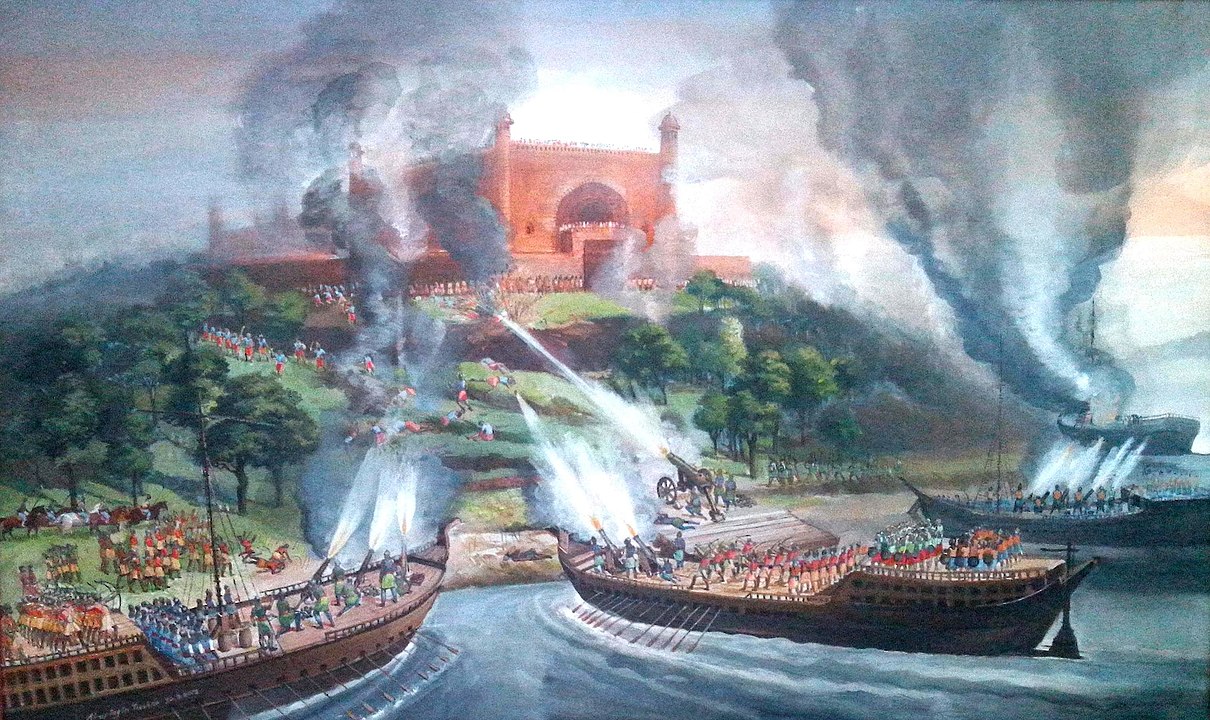In 1666 CE, I think the main new development in world history was the Mughal empire’s taking of the Bengali hub of Chittagong from their Arakanese foes. Chittagong had been a long-time outpost for the Portuguese empire in the Indian Ocean and the Mughal’s capture of it brought Portugal’s position there to an end. In the battle, the local Mughal governor, Shaista Khan– the same guy who two years ago had taken such a beating from a capable, combined naval+land force run by the Marathas on the other side of India– on this occasion assembled a capable naval+land force of his own. It’s all fascinating (though hard for me to untangle.)
In other news, 1666 saw the capture by Al-Rashid Ben Ali Al-Charif, known as Moulay Al-Rashid, of Fez in Western Morocco, where he ended the rule of the zaouia of Dila, a Berber movement, and established the Alaouite dynasty that continues to rule Morocco until today. It also saw the continuation of the Anglo-Dutch war, which was a fierce series of battles between the navies of the two countries, fought nearly wholly in the North Sea, right between them.
I’ll not say anything about the Second Anglo-Dutch War in today’s bulletin. But I’ll provide a note about the continued expansion of Spain’s colonial empires in South America and the Philippines, and then one about the Great Fire of London, before I take us all to Chittagong to unravel what was happening there.
Spain’s empire(s) continue to grow
It has been so interesting to observe that, though Spain’s power in Europe had been decreasing markedly over recent decades, the outposts of the Spanish empire in Philippines and South America continued to expand, seemingly on self-sustaining auto-pilot by this point.
English-WP’s annual aggregator for 1666 establishments in the Spanish Empire took me to four new settler facilities/cities established during the year. The two in Philippines were the City of Ligao and the City of Santo Tomas. The two in South America were the Fort de la Encarnación on the Repocura River, in Chile (described as destroyed in yet another Mapuche uprising in 1694, prior to being rebuilt) and Quilmes, which currently acts as an exurb of Buenos Aires.
The story of the founding of Quilmes was brutal and tragic. It was first established as a reducción— a “strategic hamlet”, most of which were run by the Jesuits or other Catholic organizations– into which were forcibly resettled the last remnants of an Indigenous people of that name. The Quilmes people had been force-marched there on a Trail of Tears from their ancestral homeland 1,500 km (950 miles) to the northwest.
The WP on the Quilmes people tells us this about them:

The Quilmes people, also known as Kilmes, were an indigenous tribe of the Diaguita group settled in the western subandean valleys of today’s Tucumán province, in northwestern Argentina. They fiercely resisted the Inca invasions of the 15th century, and continued to resist the Spaniards for 130 years, until being defeated in 1667. Spanish invaders relocated the last 2,000 survivors to a reservation (reducción) 20 km south of Buenos Aires. This 1,500 km journey was made by foot, causing hundreds of Quilmes to die in the process… Today, there are only a few Quilmes left in Tucumán Province.
Population at the beginning of the second half of the 17th century, is estimated in about 2,000 families, approximately 10,000 persons. When the Calchaquí Wars ended survived about 2,000 people (1665), which were taken prisoners and deported to a reservation located near Buenos Aires. But to the reservation just arrived only 200 families (about 1,000 people). In 1726, there were 141 people. William Beresford found a ghost town when he visited the reservation during the first British invasion of the River Plate in 1806. According to the last parish priest of the reserve, the last natives died in the late 18th century. The population was decimated by the high rate of infant mortality and epidemics. The government officially declared the ethnic group extinct on February 12, 1812 (but admitting that there are mestizo families)and the reservation was finally closed on August 14, 1812.
The Great Fire of London
Here are some excerpts from the WP description of the fire:
The Great Fire of London… swept through the central parts of London from Sunday, 2 September to Thursday, 6 September 1666. The fire gutted the medieval City of London inside the old Roman city wall. It threatened but did not reach the City of Westminster (today’s West End), Charles II’s Palace of Whitehall, and most of the suburban slums. It destroyed 13,200 houses, 87 parish churches, St Paul’s Cathedral, and most of the buildings of the City authorities. It is estimated to have destroyed the homes of 70,000 of the City’s 80,000 inhabitants…
Order in the streets broke down as rumours arose of suspicious foreigners setting fires. The fears of the homeless focused on the French and Dutch, England’s enemies in the ongoing Second Anglo-Dutch War; these substantial immigrant groups became victims of lynchings and street violence… The battle to put out the fire is considered to have been won by two key factors: the strong east wind dropped, and the Tower of London garrison used gunpowder to create effective firebreaks, halting further spread eastward.
The death toll is unknown but generally thought to have been relatively small; only six verified deaths were recorded. Some historians have challenged this belief claiming the deaths of poorer citizens were not recorded and that the heat of the fire may have cremated many victims, leaving no recognisable remains… The social and economic problems created by the disaster were overwhelming. Flight from London and settlement elsewhere were strongly encouraged by Charles II, who feared a London rebellion amongst the dispossessed refugees… After the fire, London was reconstructed on essentially the same medieval street plan which still exists today.
The banner image above is a 1675 painting of the fire looking toward London Bridge.
The Mughals take Chittagong
In the 16th and 17th centuries CE, Chittagong (Xatigan in Portuguese) was a significant port city lying on the eastern coast of today’s Bangladesh at the mouth of an eponymous river. The whole region around there was, as far as I can understand, a mass of competing small kingdoms and sultanates of which two of the notable ones were the Arakanese Sultanate and the Sultanate of Bengal, for which Chittagong had been the main port. Armed traders from Portugal’s large “Estado da India” operation, which was headquartered in Goa on the other side of the Indian sub-continent, first arrived in Chittagong in 1512.
English-WP tells us that in 1528 the Sultan of Bengal,
permitted the Portuguese to establish factories and customs houses in the Port of Chittagong. A fort and naval base was established in Firingi Bandar. The settlement grew into the most prominent Eurasian port on the Bay of Bengal during the Age of Discovery. The cartaz system was introduced and required all ships in the area to purchase naval trading licenses from the Portuguese. [Wow!] In 1590, the Portuguese conquered the nearby islands of Sandwip under the leadership of António de Sousa Godinho. In 1602, the Sandwip island of Chittagong was conquered by the Portuguese from Kedar Rai of Sripur.
Yes, as you can see, this WP page is not well-organized. But let’s read on to learn more about this lengthy Portuguese presence:
The harbour of Chittagong became the most important port to the Portuguese because of its location, navigational facilities and safe anchorage. The port is very close to the mouth of the Meghna which was the principal route to the [Arrakanese] Royal capital of Gouda.
Evidently the Portuguese found Chittagong a congenial place to live. By the end of the sixteenth century, the Chittagong port had emerged as a thriving port, which attracted both unofficial Portuguese trade and settlement… In 1598 there lived about 2,500 Portuguese and Eurasians in Chittagong and Arakan.
The increased commercial presence included bureaucrats, merchants, missionaries, soldiers, adventurers, sailors and pirates. The enclave had a highly laissez-faire administration led by traders. Slave trade and piracy flourished. Major traded products included fine silk, cotton muslin textiles, bullion, spices, rice, timber, salt and gunpowder.
The Roman Catholic Church was established in Bengal during Portuguese rule in Chittagong… The Portuguese also encouraged intermarriage with the local population.
In 1615, the Portuguese Navy defeated an Arakanese-Dutch VOC fleet near the port city.
And this:
The Portuguese were involved in slave business and sold their slaves in Tamluk and Balasore, and in Deccan ports. Slaves were sold at Dianga and Pipli, and transported by ship. The Portuguese built a fort at Pipli in 1599 for prisoners brought by the Arakanese. In 1629 the Portuguese under the command of Diego Da Sa raided Dhaka and took many prisoners including a Syed woman, the wife of a Mughal military officer and carried her off in chains to Dianga. The prisoners were converted to Christianity.
So the Mughals had gotten pretty close to Chittagong by then. And remember that in 1632, somewhat west of there, they had expelled the Portuguese from Hooghly. In 1663, Shaista Khan, the powerful uncle of Mughal Emperor Aurangzeb, was appointed Subahdar (governor) of Bengal. The Shaista page on WP tells us this:
Upon his arrival in Bengal, Shaista Khan was faced with putting down the Arakanese pirates. He began by rebuilding the Mughal navy, increasing its Bengal fleet to 300 battle-ready ships within a year. He also made strenuous diplomatic efforts to win the support of the Dutch East India Company as well as Portugal, which was supporting Arakan with resources and troops. With active Dutch military support, Shaista Khan led Mughal forces on an assault on the island of Sandwip, which lay in Arakanese control. Mughal forces succeeded in capturing the island in November 1665.
Shaista Khan gained a considerable advantage when a conflict erupted between the Arakanese and the Portuguese. The Portuguese, led by Captain Moor, set fire to Arakanese fleets and fled to Bhulua where Thanadar Farhad Khan gave them refuge. Farhad then sent them off to Shaista. By promptly offering protection and support, Shaista secured the aid of the Portuguese against the Arakanese.
In December 1665, Shaista Khan launched a major military campaign against Chittagong, which was the mainstay of the Arakanese kingdom. The imperial fleet consisted of 288 vessels of their own and about 40 vessels of the Firingis (Portuguese) as auxiliaries. Ibn Hussain, Shaista Khan’s admiral, was asked to lead the navy, while the subahdar himself took up the responsibility of supplying provisions for the campaign. He also ordered Farhad Khan and Mir Murtaza to take the land route. The overall command was given to Buzurg Ummed Khan, a son of Shaista Khan. The Mughals and the Portuguese held sway in the following naval battle. The conquered territory to the western bank of Kashyapnadi (Kaladan river) was placed under direct imperial administration. The name of Chittagong was changed to Islamabad and it became the headquarters of a Mughal faujdar. Khan also re-asserted Mughal control over Cooch Behar and Kamarupa.
Upon his victory against the Arakanese, he ordered the release of thousands of Bengali peasants being held captive by the Arakanese forces.
So my reading of this is that Shaista was doing a couple of things very smartly. (1) He had built a naval force to complement the land forces that had always been the Mughals’ main (or often only) strength. Maybe he had learned something from what the Maratha had achieved at his expense in Surat? By the way, the Portuguese-in-Chittagong page on WP tells us this about the battle:
The Mughals attacked the Arakanese from the jungle with a 6500-man army supported by 288 ships of war bound for the seizure of Chittagong harbour. After three days of battle, the Arakanese surrendered…
This battle involved movement across both land and water. To combat the pirates’ skill over water, the Mughals called for the support of Dutch ships from Batavia. Before the Dutch ships reached the coast of Chittagong, the battle had already ended. To carry soldiers, Shaista Khan constructed several large ships and a large number of galleys.
(2) Shaista also used some adroit diplomacy to turn the Portuguese against their longtime allies and brothers-in-piracy the Arakanese. And at the same time he brought the Portuguese firmly under his own control, in Dhaka. No more Portuguese power over licensing shipping in and around Chittagong!




